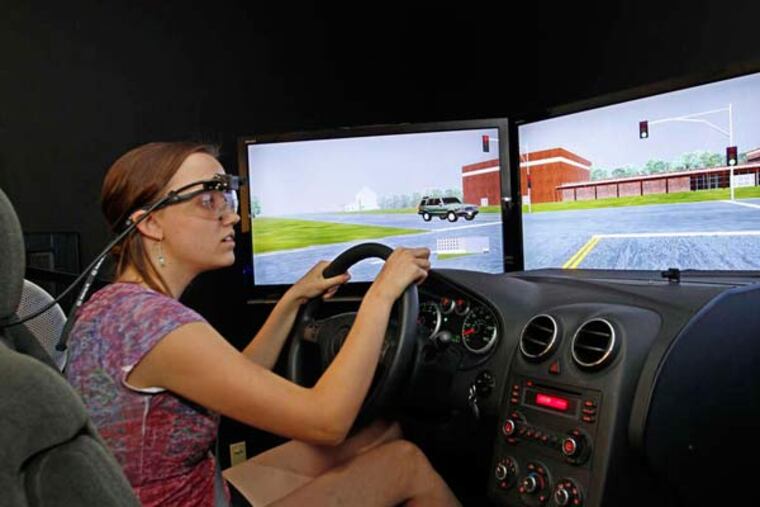Teen learns the safe way why driving is so hard
When the red sedan shot onto the road from behind a hedge, I momentarily froze. Brake! I remembered, and not a moment too soon. A split-second later, I would have crashed.

When the red sedan shot onto the road from behind a hedge, I momentarily froze. Brake! I remembered, and not a moment too soon. A split-second later, I would have crashed.
Luckily, the accident would have been virtual. I was at the wheel of a complex and hyperrealistic driving simulator under the scrutiny of researchers Flaura Koplin Winston and Catherine C. McDonald.
The pair, who are affiliated with Children's Hospital of Philadelphia and the University of Pennsylvania, expected I might have trouble with the video simulation. That's because I am a teenager.
It is no secret that in the real world, teen drivers are more accident-prone than adults, with nearly three times the crash rate per mile driven, according to the Insurance Institute for Highway Safety. Using the simulator, Winston and McDonald think they can pinpoint specific weaknesses that lead to this disparity.
In a recent study, they and their colleagues found that teens driving the virtual vehicle were more likely than adults to commit the kinds of errors that can lead to accidents - among them speeding, failing to look left and right at intersections, and following other cars too closely.
The scientists hope versions of their lab-based simulator will be used in schools, testing centers, and other venues so novice motorists can identify skills that need more practice.
"We don't want to keep it as a research product," Winston said. "We want to help people be better drivers."
The system consists of a steering wheel, dashboard, brake, and gas pedal, along with three flat-screen monitors that provide the driver with a 160-degree field of view. Each session is recorded with mounted cameras capturing the driver from every angle - including one directly above the feet and brakes.
The driver also wears goggles mounted with a device that tracks eye movement. That allows the researchers to tell whether the driver is periodically scanning side to side for hidden driveways and other pitfalls rather than just focusing straight ahead, said McDonald, an assistant professor at Penn's School of Nursing.
The simulator was assembled from off-the-shelf equipment. The researchers, at Children's Hospital's Center for Injury Research and Prevention, customized its software to measure driver activity in split-second detail.
Winston, a physician and engineer who is also a professor of pediatrics at Penn's Perelman School of Medicine, called up the video of my eye movement and analyzed my near-crash. She pointed to a black X barreling down the centerline of the road that represented my visual focus as I drove.
"You were looking straight ahead, to that stoplight several hundred meters down the road," she said. "You're not checking your mirrors enough. You're not aware of those hedges."
She gestured to the blobs of digitized greens and browns, where I saw what I had not seen before - a glint of red.
Switching to a close-up video of my feet, she added: "And see, your foot is still right on the throttle at this point, pushing that accelerator. I would be coasting here. My foot would be hovering over the brake, just in case."
These skills would come with more practice, she said. Yet most teens get their licenses without getting nearly enough experience in varied situations, Winston said.
In Pennsylvania, teens must practice driving for 65 hours with an adult in the car before they can take their road test to get a license. But many log those hours on the same roads over and over, such as driving between home and school, Winston said.
Likewise, the road tests do not involve a wide range of complex situations, she said.
A person can learn the basic mechanics of driving in 10 to 15 hours, but it takes thousands of hours in various conditions to become truly skilled, she said.
"You have to have situational awareness," Winston said. "You have to detect hazards and drive defensively. And if something comes up, you have to react."
In the simulator study, published in the journal Injury Prevention, teen drivers were good at basic skills such as using turn signals but were less adept than adults at anticipating hazards. During a 35-minute simulation, the median number of errors teens committed was 30, compared with 13 for adults.
Helen Loeb, a colleague of Winston's, has identified another shortcoming in previous research. She found teens are sometimes hesitant to slam on the brakes in an emergency situation, applying less force to the pedal than adults would.
I already have my junior license. But with the help of the driving simulator at Children's Hospital, I learned I need more practice.
Next time, I'll be on the lookout for red sedans!